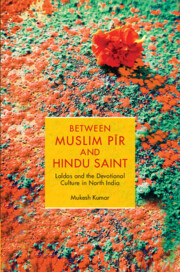Book contents
- Frontmatter
- Dedication
- Contents
- List of Figures, Maps and Tables
- Acknowledgements
- List of Abbreviations
- A Note on Transliteration
- Maps
- 1 The Spectre of Binaries
- 2 Laldas and Religious Duality of Pīr and Sant
- 3 The Laldas Shrines and Inter-religious Disputes
- 4 A Fait Accompli: The Complete Hinduisation of the Laldas Order
- 5 Religious Reform and Shared Shrines
- 6 Concealment and Secrecy: Hidden in Plain Sight
- 7 Poetic Response to Religious Puritanism
- 8 An Ephemeral Line in the Sand
- Appendices
- Glossary
- Bibliography
- Index
4 - A Fait Accompli: The Complete Hinduisation of the Laldas Order
Published online by Cambridge University Press: 30 April 2024
- Frontmatter
- Dedication
- Contents
- List of Figures, Maps and Tables
- Acknowledgements
- List of Abbreviations
- A Note on Transliteration
- Maps
- 1 The Spectre of Binaries
- 2 Laldas and Religious Duality of Pīr and Sant
- 3 The Laldas Shrines and Inter-religious Disputes
- 4 A Fait Accompli: The Complete Hinduisation of the Laldas Order
- 5 Religious Reform and Shared Shrines
- 6 Concealment and Secrecy: Hidden in Plain Sight
- 7 Poetic Response to Religious Puritanism
- 8 An Ephemeral Line in the Sand
- Appendices
- Glossary
- Bibliography
- Index
Summary
The formulation of the persona of Laldas from a nirgu bhakti follower to a sagu saint and deity is central to the rise and success of the religious order. The complete conversion of Laldas into a ‘Hindu’ saint requires a profound restructuring of his identity. This undertaking involves assigning him a new role while simultaneously erasing or modifying his traditional religious image, which had been distinguished by a shared form of religiosity. The changes observed within the Laldas order also signify a deliberate undermining of the saint's religious teachings and principles. This subversion of Laldas's original teachings implies a shift towards a more homogeneous understanding of the order, where the liminal elements of his beliefs are now incorporated into the broader narrative of neo ‘Hinduism’.
This new imagery of Laldas has been achieved by first transforming the traditional shrines spatially and then constructing new temples in various parts of north India to practice anthropomorphic image worship. It is also an effort to achieve a new social construction of a religious space. In fact, spaces contested for ideological, economic and religious reasons generally reflect efforts to create new meanings for them in a changed context, leading to spatial transformations (Low 1996). Currently, the shrines of Laldas are examples of what Lefebvre (1991: 164–68) refers to as ‘dominated space’ and ‘appropriated space’. More importantly, the spatial changes at the religious shrines of Laldas signify ongoing efforts to transform the meanings of a traditional sacred space. This is being achieved by the process of what Low (1996, 2009) describes as ‘the social construction of space’. In this process, new symbolic meanings imbued with new religious significance of Laldas are created. Devotees’ social interactions, memories and daily use of the material setting effectively transform Laldas's traditional shrine spaces into new arenas of ritual scenes and actions, ultimately Hinduising what was once a shared/mixed sacred space.
Most of these changes are quite recent in origin and are undertaken by the financially rich Baniya community. Moreover, their socio-economic power and traditional devotional beliefs also contribute to these spatial and architectural transformations at the traditional shrines. In analysing the domination of Hindus at these traditional religious sites, the main attention is paid to the structure, control, and agency of followers, on one hand, and new religious discourses and practices surrounding these sacred spaces, on the other.
- Type
- Chapter
- Information
- Between Muslim Pīr and Hindu SaintLaldas and the Devotional Culture in North India, pp. 110 - 134Publisher: Cambridge University PressPrint publication year: 2024
- Creative Commons
- This content is Open Access and distributed under the terms of the Creative Commons Attribution licence CC-BY-NC 4.0 https://creativecommons.org/cclicenses/



